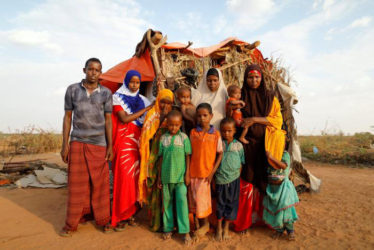DOLLOW, SOMALIA (Reuters) – As the village wells dried up and her livestock died in the scorched scrubland of southern Somalia, Abdir Hussein had one last chance to save her family from starvation: the beauty of her 14-year-old daughter, Zeinab.
Last year, an older man offered $1,000 for her dowry, enough to take her extended family to Dollow, a Somali town on the Ethiopian border where international aid agencies are handing out food and water to families fleeing a devastating drought.
Zeinab refused.
“I would rather die. It is better that I run into the bush and be eaten by lions,” said the slender dark-eyed girl in a high, soft voice.
“Then we will stay and starve to death and the animals will eat all of our bones,” her mother shot back.

The exchange, related to Reuters by the teenager and her mother, is typical of the choices facing Somali families after two years of poor rains. Crops withered and the white bones of livestock are scattered across the Horn of Africa nation.
The disaster is part of an arc of hunger and violence threatening 20 million people as it stretches across Africa into the Middle East.
It extends from the red soil of Nigeria in the west, where Boko Haram’s six-year jihadist insurgency has forced 2 million people to flee their homes, to Yemen’s white deserts in the east, where warring factions block aid while children starve.
Between them lie Somalia’s parched sands and the swamps of oil-rich South Sudan, where starving families fleeing three years of civil war survive on water-lily roots.
Parts of South Sudan are already suffering famine, the first in six years.
In Somalia, the United Nations says more than half the 12 million population need aid. A similar drought in 2011, exacerbated by years of civil war, sparked the world’s last famine, which killed 260,000 people. Now the country teeters on the brink again.
At the moment, the death toll is still in the hundreds but the numbers will spike if the March-May rains fail. The forecast is not good.
As US President Donald Trump threatens to slash aid budgets, the United Nations says the drought and conflicts in the four countries are fuelling humanity’s greatest collective disaster since World War Two.
“We stand at a critical point in history,” Undersecretary-General for humanitarian affairs Stephen O’Brien told the Security Council in March. “We are facing the largest humanitarian crisis since the creation of the United Nations.”
The United Nations needs $4.4 billion by July, he said. So far it has received $590 million.
The choice
Missing from the statistics are the heart-wrenching choices families make every day to survive.
Sheltering under the bare branches of a thorn tree as she waited for a cup of flour, one mother who just arrived in Dollow said she had been feeding her younger children while the older ones went hungry.
Another had left her sick five-year-old son by the side of the road with distant kinsmen as she led children that could still walk towards help. A third woman bid goodbye to her crippled husband and walked through the desert for a week, carrying their toddler, to the place where there was food.
Hussein traded Zeinab’s freedom for the lives of her sisters.
“I felt so bad,” she told Reuters in the ragged dome of sticks, rags and plastic that shelters her and 14 other relatives. “I ended the dreams of my baby. But without the money from the dowry, we would all have died.”
Zeinab, whose henna’d hands are also covered with her own inky teenage doodles, wears a tight-fitting headscarf and a long, drab skirt. Underneath are a pair of trousers with a spray of coloured rhinestones at the bottom, and an iron will. She wants to be an English teacher. She wants to finish school. She does not want to be married.
“I want something different to this,” she said, as her two-year-old nephew rolled naked in the sand and his baby brother cried weakly.
Weighed against Zeinab’s dreams were the lives of 20 nieces and nephews, the sons and daughters of her three elder sisters, all married young and all widowed or divorced. There was also her careworn older brother, her gap-toothed younger sister and her middle-aged parents.
Once the family had cows and goats and three donkeys that they hired out with carts for transport. But the animals died around them and Zeinab became their only hope of escape.
For a month, she refused, withdrawing into herself and running away when they forgot to lock her in her room. Finally, faced with her family’s overwhelming need, Zeinab relented.
“We didn’t want to force her,” her mother said wearily, worry lines etched into her forehead as her daughter sat stony-faced beside her. “I could not sleep for stress. My eyes were so tired I could not thread a needle.”
The marriage
The dowry was received, the marriage celebrated, and union consummated. Zeinab stayed three days and ran away.
When her family hired cars to drive them the 40 kilometres to Dollow, Zeinab went with them. She enrolled in the local school, where stick walls topped by corrugated iron sheets serve as classrooms for 10 teachers and around 500 students.
Her husband followed.
“He says, if the girl refuses me I must get my money back. Or I will take her by force,” Zeinab said quietly. “He sends me messages saying give me the money or I will be with you as your husband.”
Her family cannot repay even a fraction of the dowry. Their only assets are their two stained foam mattresses, three cooking pots and the orange tarpaulin that covers their makeshift dome. There is nothing else to sell.
Then Zeinab’s English teacher Abdiweli Mohammed Hersi decided to step in. Hersi has seen hundreds of students drop out due to the drought.
One girl left to work as a maid to help feed her family. Her generation was the first where the daughters were sent to school. A boy sickened and died; cholera has exploded throughout Somalia as the bacteria infects dwindling water supplies.
Five girls this year also left for forced or early marriages, Hersi said. Young, reluctant brides are not unheard of in Somalia, but they are less common in good times, he said, at least in Dollow.
“Before the drought, the cases were less,” he said, an inflatable globe hanging from the ceiling of his classroom. “Some parents do give their children to other men to get that money.”
The end
No one knows how many families are making choices like Zeinab’s.
“While we don’t yet have firm data, we understand from some reports that the numbers are small but increasing, particularly in the south and central regions,” said Jean Lokenga, chief of Child Protection for the United Nations Children’s Fund in Somalia.
Other aid groups said most drought-stricken families are too poor to pay dowries after their animals died. None knew of a programme to help girls like Zeinab.
Hersi took Zeinab to a local aid group, who took her to Italian aid group Cooperazione Internazionale. The regional coordinator, visiting on a trip with EU donors, decided to intervene.
“We must do something for this girl,” said Deka Warsame, pouring tea for colleagues gathered to hear the story as the call to prayer sounded through the rooftops. “Otherwise it will be a rape every night.”
Her staff held a collection and came up with enough cash to repay the dowry. Warsame told Zeinab the group would mediate a meeting between the men of the two families. Her husband would get back his money if he divorced her in front of witnesses.
Zeinab’s dark eyes flicked up from the floor.
“Will I be free?” she asked.








